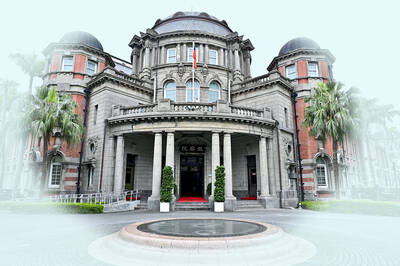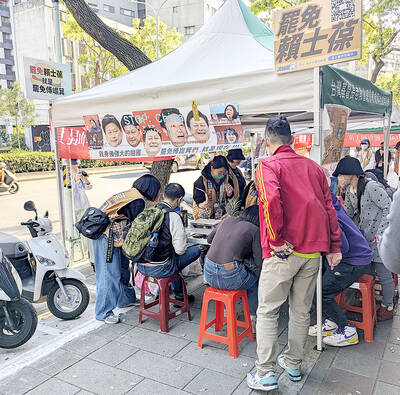New immigrants and migrant workers from Southeast Asian countries long ago became part of Taiwanese society. Yet their stories and experiences are rarely covered in the mainstream media, let alone on the big screen. Detours to Paradise (歧路天堂), the feature debut by film critic, scholar and English teacher Rich Lee (李奇), is an admirable attempt at portraying the country’s undocumented foreign laborers as real people and addressing their plight in an arresting story that stars a strong multinational cast from Indonesia, Thailand and Taiwan.
The film centers on Setia (Lola Amaria), an undocumented migrant worker from Indonesia who drifts from Taoyuan to Taipei working odd jobs for a meager living. Her lover Supayong (Banlop Lomnoi) is a Thai construction worker. In each other’s arms, the two find mutual comfort and solace, conversing in simple Mandarin and dreaming that one day they will have a comfy bed to share.
At the massage parlor where she works as a cleaning lady, Setia grows close to Wonpen (Niki Wu, 吳立琪), a Thai worker who changes her identity to re-enter the country. Soon after Wonpen leaves, Setia switches jobs to work at a noodle shop where she meets retired movie star Fei Man-guang (Yang Kuei-mei, 楊貴媚). Paralyzed from the waist down, Fei is a suicidal heavy drinker who is addicted to painkillers.
Fei gradually accepts Setia as her caretaker. However, the story takes an unexpected turn when Setia discovers that her new employer was responsible for the car accident that killed her older sister, who worked as Fei’s maid. Meanwhile, the police catch Supayong and he faces imminent deportation.
In the end, Setia is left alone in an unforgiving country. Like countless others, she continues to plod along as an undocumented migrant despite the hardship.
With the participation of Hou Hsiao-hsien’s (侯孝賢) filmmaking comrades including cinematographer Lee Ping-bing (李屏賓), editor Liao Ching-sung (廖慶松) and art director Huang Wen-ying (黃文英), Detours to Paradise exudes a sense of realism that is reminiscent of Taiwanese New Wave cinema. Slow pacing, long takes shot from a distance and minimal dialogue recall the early work of Hou and Tsai Ming-liang (蔡明亮).
Lee shows a flair for storytelling through the film’s mise en scene. The scene in which Setia is seen standing alone in a scrapyard shortly after she arrives in Taipei tersely conveys the runaway laborer’s powerlessness amid the hostile environment. An inescapable sense of confinement is present even in the scene in which Setia and Lomnoi sleep soundly in a hotel room as the camera pans to reveal the iron lattice window.
The film takes a melodramatic turn when Yang’s character Fei enters the picture. The cinematography and art direction become abstract and Yang’s acting more stylistic, which contrast the film’s overall tone. This section’s incoherent style, though a flaw to some, effectively portrays the collision between two worlds. The slightly theatrical treatment of Fei’s life suggests that what is perceived as normal in Taiwan is, in fact, exotic and alien to Setia.
The strong multinational cast turns in naturalistic performances that enhance the film’s slices-of-life feel. Indonesian actress and film director Amaria comes off as a sympathetic lead with her absorbingly understated performance. Noted for his work in Tropical Malady by Cannes-winning director Apichatpong Weerasethakul, non-professional actor Lomnoi from Thailand possesses natural charisma and a strong presence that recalls Lee Kang-sheng (李康生) in Tsai’s works.
Taiwanese actress Wu, who, through her convincing performance as the Thai servant, demonstrates great potential as a serious actor.
Though disconnected at times, Detours to Paradise is a commendable piece of filmmaking and shows that the spirit of New Wave cinema is still alive and kicking.

That US assistance was a model for Taiwan’s spectacular development success was early recognized by policymakers and analysts. In a report to the US Congress for the fiscal year 1962, former President John F. Kennedy noted Taiwan’s “rapid economic growth,” was “producing a substantial net gain in living.” Kennedy had a stake in Taiwan’s achievements and the US’ official development assistance (ODA) in general: In September 1961, his entreaty to make the 1960s a “decade of development,” and an accompanying proposal for dedicated legislation to this end, had been formalized by congressional passage of the Foreign Assistance Act. Two

Despite the intense sunshine, we were hardly breaking a sweat as we cruised along the flat, dedicated bike lane, well protected from the heat by a canopy of trees. The electric assist on the bikes likely made a difference, too. Far removed from the bustle and noise of the Taichung traffic, we admired the serene rural scenery, making our way over rivers, alongside rice paddies and through pear orchards. Our route for the day covered two bike paths that connect in Fengyuan District (豐原) and are best done together. The Hou-Feng Bike Path (后豐鐵馬道) runs southward from Houli District (后里) while the

The Taipei Times last week reported that the Control Yuan said it had been “left with no choice” but to ask the Constitutional Court to rule on the constitutionality of the central government budget, which left it without a budget. Lost in the outrage over the cuts to defense and to the Constitutional Court were the cuts to the Control Yuan, whose operating budget was slashed by 96 percent. It is unable even to pay its utility bills, and in the press conference it convened on the issue, said that its department directors were paying out of pocket for gasoline

On March 13 President William Lai (賴清德) gave a national security speech noting the 20th year since the passing of China’s Anti-Secession Law (反分裂國家法) in March 2005 that laid the legal groundwork for an invasion of Taiwan. That law, and other subsequent ones, are merely political theater created by the Chinese Communist Party (CCP) to have something to point to so they can claim “we have to do it, it is the law.” The president’s speech was somber and said: “By its actions, China already satisfies the definition of a ‘foreign hostile force’ as provided in the Anti-Infiltration Act, which unlike